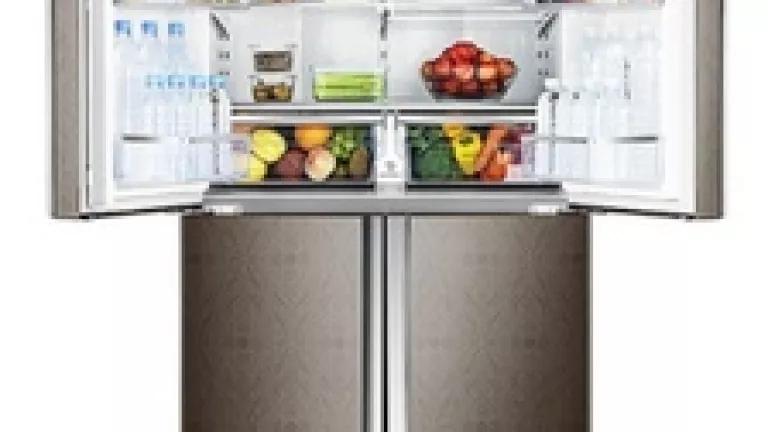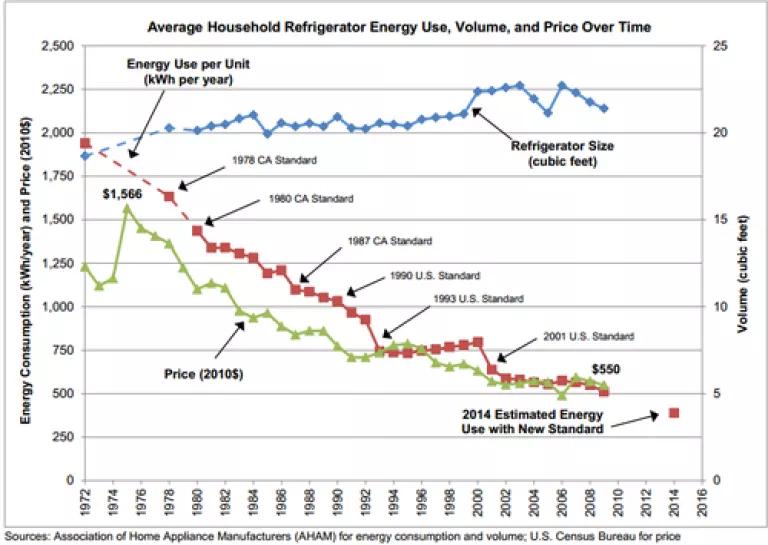
New refrigerators and freezers will use significantly less energy – with the majority of models cutting their energy use by 20 to 25 percent – under updated energy efficiency standards going into effect Monday. This latest step forward in a long history of improved energy savings proves that efficiency is truly the low hanging fruit that keeps growing back!
These new refrigerators and freezers are expected to save consumers between $215 and $270 on their annual utility bills compared to a refrigerator that just met the first state standards in 1978, and result from a 2010 consensus recommendation to the Department of Energy (DOE) from refrigerator manufacturers, efficiency advocates, states, and consumer groups. DOE approved the standards in 2011 for refrigerators and freezers, making the energy-saving targets effective for manufacturers on Sept. 15, 2014.
The refrigerator standards were last updated in 2001, but with improvements in refrigeration technologies and innovation on the part of manufacturers these new standards—not surprisingly—offers a significant reduction in energy use. Some potential improvements that manufacturers may use to meet the standards include improved insulation technologies (such as vacuum insulated panels), higher efficiency fan motors, better heat exchangers, and more efficient compressors.
In fact, the new standards are anticipated to save almost 5 quads of energy over the next 30 years – equivalent to 5 percent of the total energy used in the U.S. in one year – and result in approximately $36 billion in net energy bill savings. They’re also estimated to save about 344 million metric tons of carbon dioxide emissions during this same time period, equivalent to the annual greenhouse gas emissions of about 70 million cars. These new standards are a fresh chapter in the astounding success story of refrigerator energy standards.
The refrigerator is just one of over 50 products covered by U.S. DOE standards. Together, the products covered by DOE represent a whopping 90 percent of the energy used in our homes, 60 percent of our commercial building energy use, and approximately 29 percent of industrial energy use. And, as with refrigerators, they have spurred remarkable product innovation along with huge energy and consumer bill savings. (We’ll be talking more about these successes and the processes that got them there in the coming weeks – stay tuned!)
New chapter in a huge success story
The new refrigerator and freezer standards represent a fresh chapter in the astounding success story of fridge energy standards. The first refrigerator efficiency standards were established in 1978 in California. Before that refrigerators were using more and more energy each year – largely due to their increasing size. There was simply no incentive for efficiency as the market encouraged design changes that saved money up front even if they ended up costing customers much more over the life of the product.
Once California set the first standards, refrigerator energy use finally begin to decline—without compromising performance. Now on the fourth iteration of a national standard, refrigerator efficiency has improved continually for almost four decades, thanks to a combination of standards, utility incentive programs, ENERGY STAR™ labeling, federal tax credits and the Golden Carrot initiative. Under the new standards, the average refrigerator will use less than a quarter of the energy it did in the 70’s while being larger, cheaper, and including more features.

Source: Appliance Standards Awareness Project
Each time the government updates efficiency standards, they are set at the maximum levels that are cost-effective at the time. Because standards are technology neutral, manufacturers are free to innovate and find new ways to achieve higher levels of efficiency and at lower costs.
For an individual consumer the savings are significant: thanks to continued improvements in refrigerator efficiency standards, a new refrigerator meeting the latest standards will save an average homeowner hundreds of dollars on their energy bills annually compared to the 1970s counterpart.

Source: Appliance Standards Awareness Project
The updated standards apply to the date of manufacture, so consumers will begin to see these savings over the coming months as the stock in store turns over. Consumers looking for even greater energy savings should look for an ENERGY STAR™ model – the voluntary ENERGY STAR levels are being updated at the same time as the new federal standards go into effect. To qualify for ENERGY STAR, fridges must to be at least 10 percent more efficient than the updated standards.
It’s great to see the refrigerator and freezer standards finally going into effect, delivering savings to consumers and the climate alike. These standards contribute to the 2 billion metric tons of carbon dioxide emissions reductions already on the books toward meeting the President’s Climate Action Plan goals.
